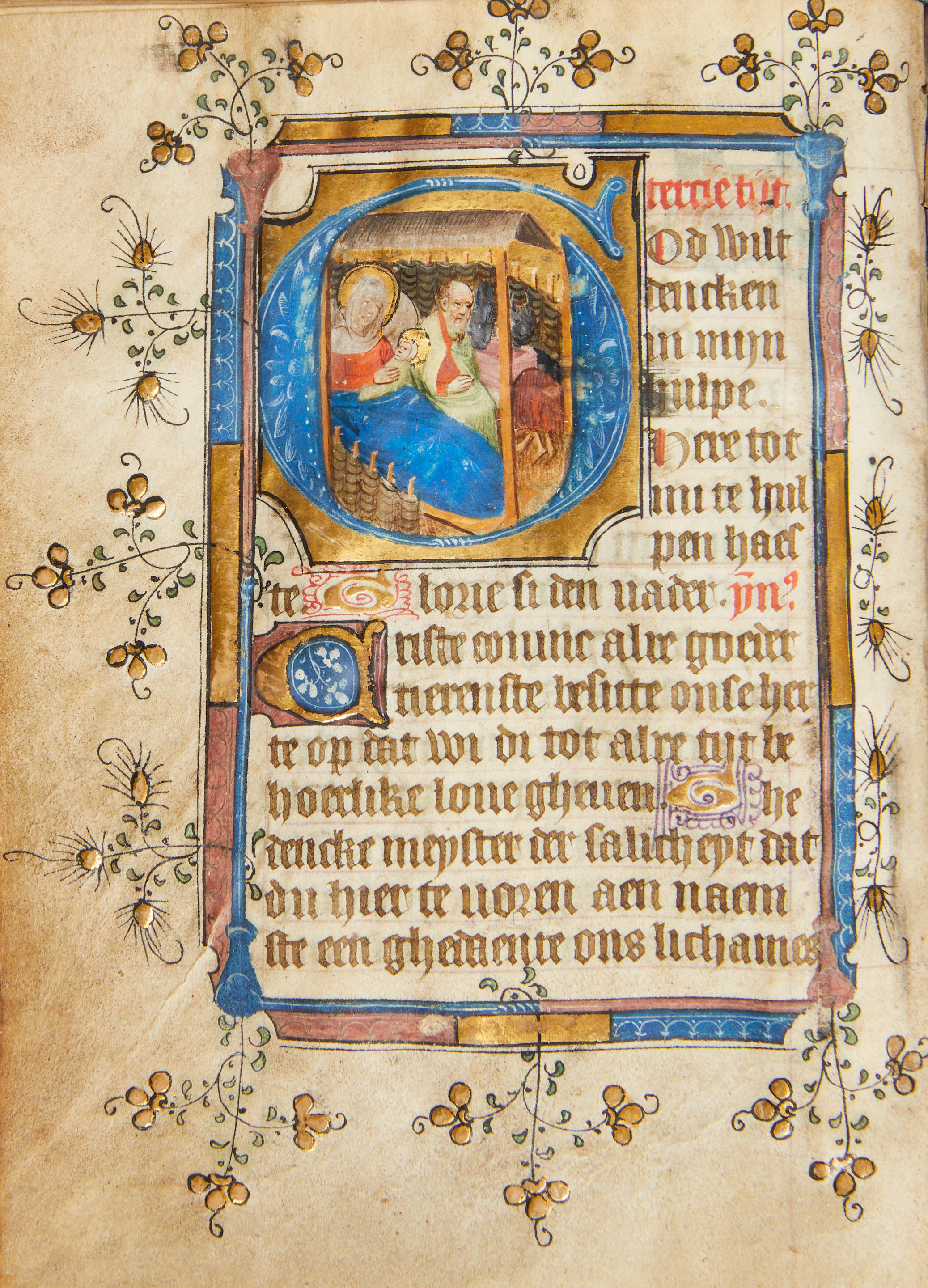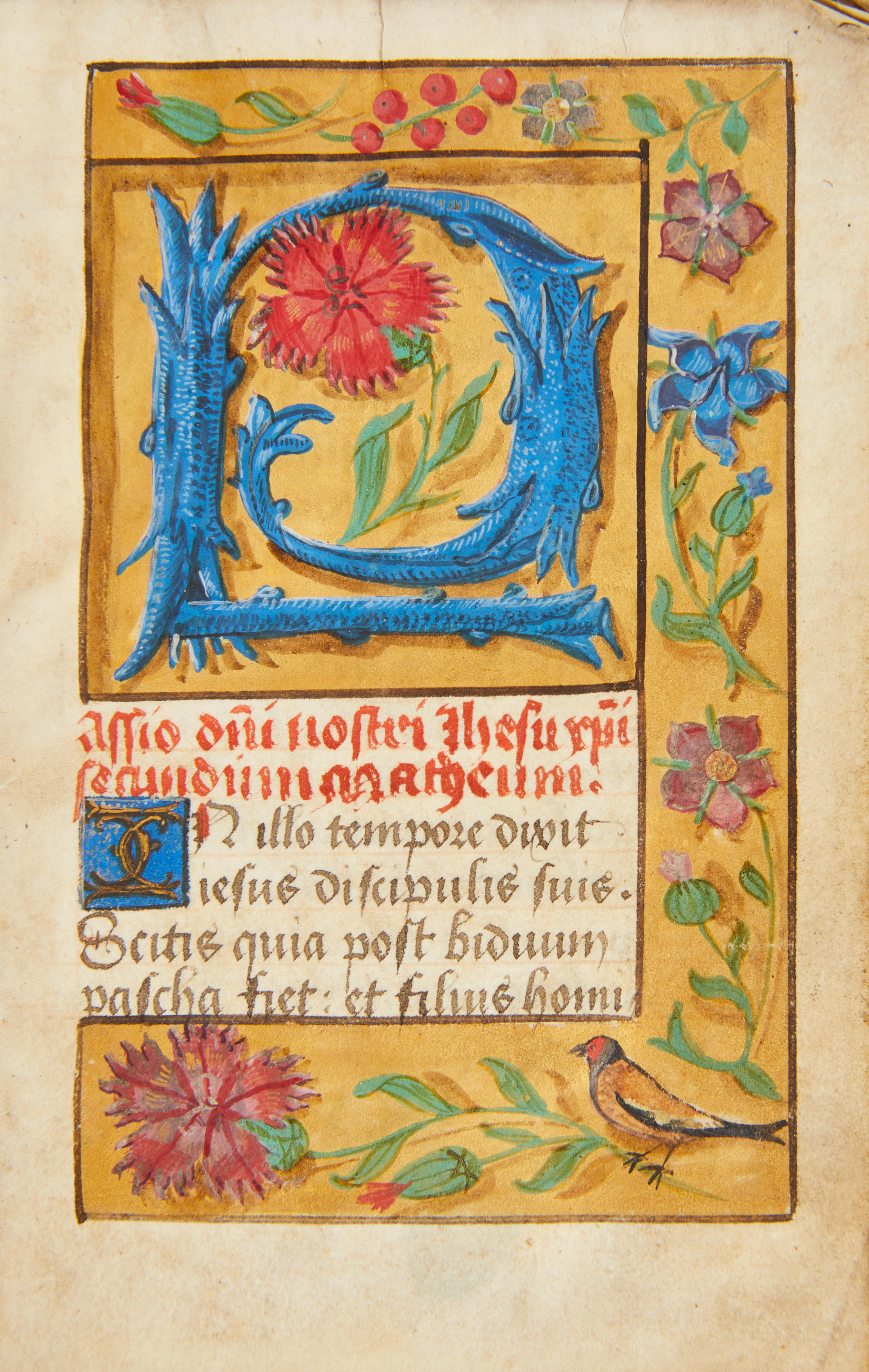DEVOTIONAL TEXTS, in Dutch, illuminated manuscript on vellum [Zutphen, c.1485].
DEVOTIONAL TEXTS, in Dutch, illuminated manuscript on vellum [Zutphen, c.1485]. 146 x 102 mm. ii paper + 219 + ii paper leaves: 1-13 8 , 14 7 (of 8, lacking i), 15 8 , 16 10 , 17-26 8 , 27 10 , 20-22 lines written in black ink in a gothic hybrid bookhand between two horizontals and two verticals ruled in ink, ruled space: 96 x 71mm, large flourished initials in blue or red or both, some with gold, leading to penwork borders some with figures, four illuminated initials, six illuminated partial borders (lacking one leaf after f.104, slight staining to some margins) . 19th-century stamped vellum (slight scuffing). PROVENANCE : (1) The illumination is typical of small group of manuscripts associated with the two houses of Franciscan tertiaries in Zutphen. The penwork and language also indicate the eastern area of the Northern Netherlands. (2) Gift of JOSEPH W. DREXEL, 1889, to the Metropolitan Museum of Art. CONTENTS : Abbreviated narratives of the life of Christ, concluding with Pentecost, with some prayers, ff.2v-55; Willem Jordaens (c.1321-1372): Hundred Articles on the Passion , the Dutch translation of Jordaens’s Latin version of Henry Suso ff.55-72; prayers and other texts ff.73-129v; prayers to the Virgin and Christ for the days of the week ff.129v-165; sequences of prayers, kranskens (garlands), to the Virgin ff. 165-189v; Seven Psalms of the Virgin ff. 179v-199v; prayers to the Virgin and St Joseph ff.199v-217v. The vernacular compilation is typical of those produced by, and for, the followers of Geert Grote and the devotio moderna. ILLUMINATION : The illuminated borders can be localized by comparison with a Missal for the use of IJzendoorn (Zutphen, St Walburgiskerk, ms 3) to one of the two houses of Franciscan Tertiaries in Zutphen, either IJzendoorn itself, dedicated to St Mary Magdalene, or the Heer Hendrikshuis dedicated to St Catherine. Both began as communities of Sisters of the Common Life, inspired by Gert Grote’s original Fraterhouse in Deventer at the heart of the devotio moderna . The colourful gilded borders share many features, including the delightful birds, with those in two Books of Hours (The Hague, KB, ms 77 L 58, sold at Christie's, 25 January 1992, lot 13), and Nuremberg, Germanisches Nationalmuseum, ms 18432, and a Prayerbook, sold at Christie's, 8 June 2011, lot 10. The varied leaf and flower forms of the penwork borders of the current lot are also a feature of the Prayerbook but that lacks the appealing figurative elements of birds and beasts – including a goat, with shepherd’s clothes and pipe, teaching two kids to read (f.130) and grotesques attacking a lion (f.173) - and human figures, mostly busts, but with a full-length Virgin and Child on f.165. The prancing Lamb of God (f.189v) may connect this accomplished penwork to Zutphen since illuminated roundels with a somewhat similar Lamb are a distinguishing feature of the group. Otherwise these illuminators did not produce miniatures, instead relying on prints for pictorial embellishments. The style of the illuminated borders derives from that of the so-called Masters of Margriet Uutenham, who were almost certainly nuns of the Convent of Bethany at Arnhem, a house of Augustinian canonesses, the alternative order for the communities inspired by the devotio moderna . Although women could be involved in book production in the secular world, convents often provided training and resources that women would have found difficult to access elsewhere. The Franciscan sisters in Zutphen may have been inspired by Bethany's example to supplement their revenues through book embellishment if not actual book production. How far they acted as scribes in uncertain: the regular hybrid script, fostered by Grote’s followers, could have been penned in a connected male or female house, possibly in Deventer. See U. Weekes, Early Engravers and Their Public; The Master of the Berlin Passion and Manuscripts from Convents in the Rhine-Maas Region , 2004, pp.161-3, an
DEVOTIONAL TEXTS, in Dutch, illuminated manuscript on vellum [Zutphen, c.1485].
DEVOTIONAL TEXTS, in Dutch, illuminated manuscript on vellum [Zutphen, c.1485]. 146 x 102 mm. ii paper + 219 + ii paper leaves: 1-13 8 , 14 7 (of 8, lacking i), 15 8 , 16 10 , 17-26 8 , 27 10 , 20-22 lines written in black ink in a gothic hybrid bookhand between two horizontals and two verticals ruled in ink, ruled space: 96 x 71mm, large flourished initials in blue or red or both, some with gold, leading to penwork borders some with figures, four illuminated initials, six illuminated partial borders (lacking one leaf after f.104, slight staining to some margins) . 19th-century stamped vellum (slight scuffing). PROVENANCE : (1) The illumination is typical of small group of manuscripts associated with the two houses of Franciscan tertiaries in Zutphen. The penwork and language also indicate the eastern area of the Northern Netherlands. (2) Gift of JOSEPH W. DREXEL, 1889, to the Metropolitan Museum of Art. CONTENTS : Abbreviated narratives of the life of Christ, concluding with Pentecost, with some prayers, ff.2v-55; Willem Jordaens (c.1321-1372): Hundred Articles on the Passion , the Dutch translation of Jordaens’s Latin version of Henry Suso ff.55-72; prayers and other texts ff.73-129v; prayers to the Virgin and Christ for the days of the week ff.129v-165; sequences of prayers, kranskens (garlands), to the Virgin ff. 165-189v; Seven Psalms of the Virgin ff. 179v-199v; prayers to the Virgin and St Joseph ff.199v-217v. The vernacular compilation is typical of those produced by, and for, the followers of Geert Grote and the devotio moderna. ILLUMINATION : The illuminated borders can be localized by comparison with a Missal for the use of IJzendoorn (Zutphen, St Walburgiskerk, ms 3) to one of the two houses of Franciscan Tertiaries in Zutphen, either IJzendoorn itself, dedicated to St Mary Magdalene, or the Heer Hendrikshuis dedicated to St Catherine. Both began as communities of Sisters of the Common Life, inspired by Gert Grote’s original Fraterhouse in Deventer at the heart of the devotio moderna . The colourful gilded borders share many features, including the delightful birds, with those in two Books of Hours (The Hague, KB, ms 77 L 58, sold at Christie's, 25 January 1992, lot 13), and Nuremberg, Germanisches Nationalmuseum, ms 18432, and a Prayerbook, sold at Christie's, 8 June 2011, lot 10. The varied leaf and flower forms of the penwork borders of the current lot are also a feature of the Prayerbook but that lacks the appealing figurative elements of birds and beasts – including a goat, with shepherd’s clothes and pipe, teaching two kids to read (f.130) and grotesques attacking a lion (f.173) - and human figures, mostly busts, but with a full-length Virgin and Child on f.165. The prancing Lamb of God (f.189v) may connect this accomplished penwork to Zutphen since illuminated roundels with a somewhat similar Lamb are a distinguishing feature of the group. Otherwise these illuminators did not produce miniatures, instead relying on prints for pictorial embellishments. The style of the illuminated borders derives from that of the so-called Masters of Margriet Uutenham, who were almost certainly nuns of the Convent of Bethany at Arnhem, a house of Augustinian canonesses, the alternative order for the communities inspired by the devotio moderna . Although women could be involved in book production in the secular world, convents often provided training and resources that women would have found difficult to access elsewhere. The Franciscan sisters in Zutphen may have been inspired by Bethany's example to supplement their revenues through book embellishment if not actual book production. How far they acted as scribes in uncertain: the regular hybrid script, fostered by Grote’s followers, could have been penned in a connected male or female house, possibly in Deventer. See U. Weekes, Early Engravers and Their Public; The Master of the Berlin Passion and Manuscripts from Convents in the Rhine-Maas Region , 2004, pp.161-3, an

.jpg)
.jpg)



.jpg)


.jpg)
Testen Sie LotSearch und seine Premium-Features 7 Tage - ohne Kosten!
Lassen Sie sich automatisch über neue Objekte in kommenden Auktionen benachrichtigen.
Suchauftrag anlegen